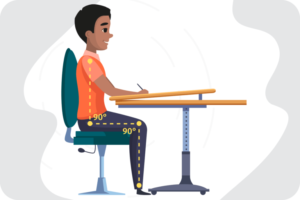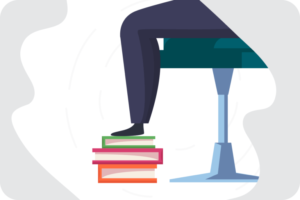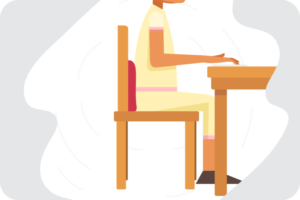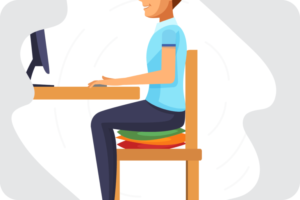If you cringe when you see your kids lounging on the couch or slouching at the dining room table, bent over an electronic device while tackling their homework each evening, you’re far from alone. In today’s digital age, most students from elementary school to college are spending a significant amount of time doing homework on laptops or tablets. This tends to lead to kids ditching desks and landing in bean bags and beds simply because pencil and paper is generally a thing of the past.
We’ve all heard of tech neck, often referred to as text neck due to the association with how much time is spend on cell phones in the modern age. Homework, it seems, exasperates an already challenging situation and families everywhere are tasked with creating comfortable and ergonomically correct and safe workstations for their children, who often don’t see the point, at least, initially.
“Abnormal postures and positions place undue stress and strain on our bodies,” explains physical therapist Nicole Barnes. “Making small adjustments can make a world of difference to how your child feels. If they are comfortable, they’re better able to pay attention, which leads to increased school success.”
Barnes, a certified ergonomic assessment specialist, emphasizes the importance of neutral posture, in which the musculoskeletal system is the most efficient.
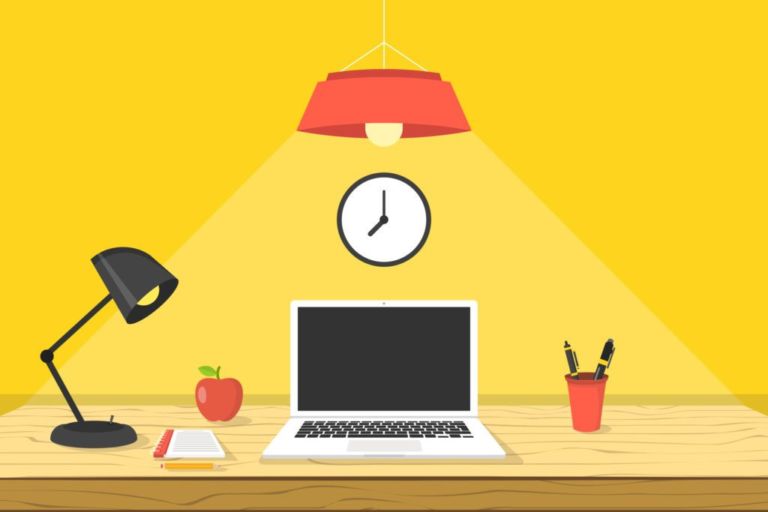
“If we can set our kids up with healthy ergonomic habits now, these habits will stay with them through adulthood and serve their bodies well for life,” Barnes says.
“Abnormal postures and positions place undue stress and strain on our bodies. Making small adjustments can make a world of difference to how your child feels.”
– Physical Therapist Nicole Barnes
How should I set up my child’s homework station?
Providing kids with a workstation that fits them is the best way to ensure they practice proper ergonomic habits. This doesn’t have to mean going out and buying new furniture either! There are plenty of simple hacks you can use to make what you already have work for your kids.
Give them a boost
Forearms should rest on the desktop, with elbows lined up under the shoulders. If typing or using a mouse, your child’s elbows should be bent just less than 90 degrees. If the chair is not adjustable and is too short for the desktop, give them a boost with a cushion or a few towels folded and stacked.
Adjust the screen height
Forehead should line up with the top of the device screen to eliminate the need to bend the neck and head over to see. Use a riser, or simply a stack of books, to elevate small laptops and tablets when watching or reading is the primary objective. Position the screen about an arm’s length away.
Ideally, if working on a laptop or tablet, kids will have a separate keyboard and mouse to use for typing so the screen can always be positioned out in front of the eyes. An external monitor is another option. If an extra keyboard or extra monitor is not an option, a laptop can be angled by positioning something beneath the back near the device’s hinge. This will raise the screen somewhat while maintaining the lower position of the keyboard.
It’s important to remember that it’s unrealistic to expect kids to hold one posture all day long. Encourage regular breaks, especially during lengthy assignments, and allow for alternative positions and postures for short periods throughout homework time.
Encourage your child to take breaks and stretch.
Make the most of your kids’ movement and brain breaks. Encourage a variety of activities during evening homework sessions, but commit to incorporating a simple stretching routine to combat the stress and strain caused by sitting for prolonged periods. Check out this video to see how easy it can be!
What are some signs of discomfort from bad posture?
While some kids will be direct in complaining about aches and pains, it’s important to know the cues to be on the lookout for in case your child doesn’t speak up about being uncomfortable. Bad posture stemming from a poor homework station setup can lead to headaches, neck and back pain, wrist pain and even leg pain.
When kids struggle to pay attention and stay focused, it may be due to discomfort caused by stiff, aching muscles, Barnes explains.
Watch for frequent fidgeting, wiggly bodies and constant shifting of positions. If your child gets frustrated and falls behind on their work, or doesn’t seem to be able to keep track of their schedule or what they’re supposed to be doing, it may be time to check their workstation to ensure you have them set up for success.

A more subtle sign of poor posture is sloppy handwriting.
“Compare your handwriting if you are lying face-down propped up on your elbows to your handwriting if you are sitting or standing at a desk in neutral posture,” Barnes suggests.
If your child’s work is done primarily on a keyboard rather than with a pencil and paper, you may notice slow typing or an abundance of errors.
Whether the signs they’re exhibiting are obvious or not, Barnes urges, recognizing your child’s musculoskeletal stress can be a critical first step to making necessary changes that will benefit them throughout the school year and beyond.
Is your child experiencing pain or discomfort?
Schedule an assessment with us!
If you have questions about creating a regular activity routine for your child, or if your child is complaining about bone, joint or muscle pain – especially during or after exercise – give us a call to schedule an assessment today. Don’t let their discomfort keep them from getting the movement they need to keep their body and brain happy and healthy.

Most insurance policies include direct access coverage, so you can see a physical therapist without a physician’s prescription or referral.
We are happy to verify your benefits for you.
Would you prefer to chat with someone on the phone? No problem! Contact your preferred location today.

